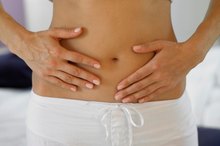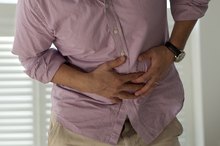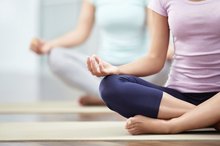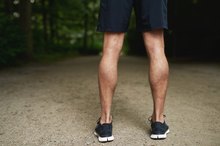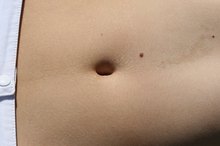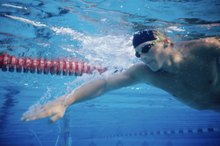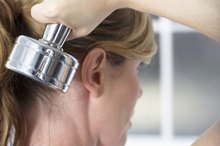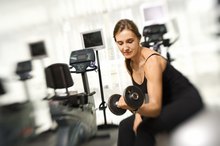What does fact checked mean?
At Healthfully, we strive to deliver objective content that is accurate and up-to-date. Our team periodically reviews articles in order to ensure content quality. The sources cited below consist of evidence from peer-reviewed journals, prominent medical organizations, academic associations, and government data.
The information contained on this site is for informational purposes only, and should not be used as a substitute for the advice of a professional health care provider. Please check with the appropriate physician regarding health questions and concerns. Although we strive to deliver accurate and up-to-date information, no guarantee to that effect is made.
Stomach Pain & Pilates
If you are new to Pilates, some of the exercises have the potential to work your ab muscles hard enough that they become strained. Some soreness is to be expected when you start a new exercise, but stomach pain during and after Pilates may mean that you have overexerted yourself in one of the poses and strained or torn your abdominal muscle. Beginner Pilates students are best served by a competent certified teacher who can help them recognize their limit and ease into the more advanced poses.
If you are experiencing serious medical symptoms, seek emergency treatment immediately.
Muscle Strain
Stomach pain represents the primary symptom of a strain in your abdominal muscle 1. Other symptoms include tenderness, a feeling of heat and inflammation in one region of the abdominal muscle. In more severe strains the pain will be sharp and stabbing and more intense when your abdominal muscles contract, such as during the Pilates 100s exercise. If these symptoms apply, the treatment involves rest, ice and heat therapy. Avoid Pilates classes altogether until the pain has subsided completely.
- Stomach pain represents the primary symptom of a strain in your abdominal muscle 1.
- In more severe strains the pain will be sharp and stabbing and more intense when your abdominal muscles contract, such as during the Pilates 100s exercise.
Muscle Imbalances
Abdomen Inflamed Because of Physical Exercise
Learn More
Stomach pain experienced during Pilates exercises may also indicate that you have muscle imbalances among your core muscles. In this case different muscles will fatigue earlier than other muscles, cause pain, and also be more likely to encounter a strain. This often happens in athletes who only do crunches but no exercises to work the other core muscles such as the obliques. Pilates works all the core muscles in concert, so it offers a superb way to equalize muscle strength and endurance. Work at your own pace in the Pilates class and stop the exercise when you feel pain. Regular practice will help your core muscles achieve balance.
- Stomach pain experienced during Pilates exercises may also indicate that you have muscle imbalances among your core muscles.
- Pilates works all the core muscles in concert, so it offers a superb way to equalize muscle strength and endurance.
Tips
An adequate warmup is a crucial component of any exercise program, and a Pilates class is not exception. Warm abdominal muscles are less likely to encounter a strain and cause stomach pain, since a warmup raises your internal temperature, lubricates your muscles, joints and connective tissue and provides more flexibility. One simple way to ensure you are properly warmed up for your Pilates class is to perform a session of cardio immediately before the class.
Warning
Sit Ups Before Bed to Lose Weight
Learn More
Resist the temptation to “push through” the pain if you experience pain in your stomach while performing Pilates exercises. Allow your body the time it needs to rest and heal the strain Typically muscle strains heal within two weeks. Ignoring the pain may lead to a rupture of the stomach muscle, which in some cases requires surgery 1.
Related Articles
References
- SportsInjuryClinic.net: Abdominal Strain: Inflammation or Rupture of the Stomach Muscles
- ACE Fitness: Pilates Primer
- American Academy of Orthopaedic Surgeons: Warm Up, Cool Down and Be Flexible
- Kloubec JA. Pilates for improvement of muscle endurance, flexibility, balance, and posture. J Strength Cond Res. 2010;24(3):661-7. doi:10.1519/JSC.0b013e3181c277a6
- Geremia JM, Iskiewicz MM, Marschner RA, Lehnen TE, Lehnen AM. Effect of a physical training program using the Pilates method on flexibility in elderly subjects. Age (Dordr). 2015;37(6):119. doi:10.1007/s11357-015-9856-z
- Lin HT, Hung WC, Hung JL, Wu PS, Liaw LJ, Chang JH. Effects of pilates on patients with chronic non-specific low back pain: a systematic review. J Phys Ther Sci. 2016;28(10):2961-2969. doi:10.1589/jpts.28.2961
Writer Bio
Emma Cale has been writing professionally since 2000. Her work has appeared in “NOW Magazine,” “HOUR Magazine” and the “Globe and Mail.” Cale holds a Bachelor of Arts in English from the University of Windsor and advanced writing certificates from the Canadian Film Centre and the National Theatre School of Canada.
